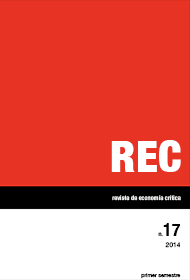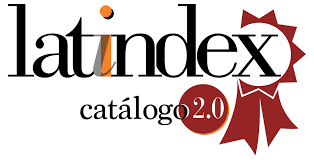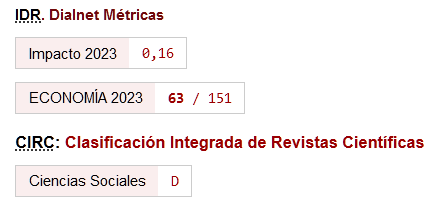¿La Unión Monetaria explica la crisis?
Downloads
References
Alvarez, I., Luengo, F. y Uxó, J. (2013): Fracturas y crisis en Europa, Clave Intelectual-Eudeba, Madrid.
Artus, P. (2012): "The euro zone's structural problems: The crucial issue is technological progress, more than cost-competitiveness", Flash Economics. Economic Research, 21 de septiembre, Nº 619. Url: http://cib.natixis.com/flushdoc.aspx?id=66016
Artus, P. (2013): "The causes of the crisis differ markedly between Spain, on the one hand, and France and Italy, on the other", Flash Economics. Economic Research, 28 de enero, Nº 66. Url: http://cib.natixis.com/flushdoc.aspx?id=68072
Boyce, J. K. (2013): "Pursuing Profits- or Power?", Dollars & Sense, Vol. julio/agosto. Url: http://dollarsandsense.org/archives/2013/0713boyce.html
Boyer, R. (2013): "The euro crisis: undetected by conventional economics, favoured by nationally focused polity", Cambridge Journal of Economics, Vol. 37, págs: 533-569
https://doi.org/10.1093/cje/bet013
Brancaccio, E. (2012): "Current account imbalances, the Eurozone crisis, and a proposal for a "European Wages Standard", International Journal of Political Economy, Nº 1, Vol. 41, abril, págs: 47-65. https://doi.org/10.2753/IJP0891-1916410102
Consejo Económico y Social (2013): Informe sobre la distribución de la renta en España: Desigualdad, cambios estructurales y ciclos, Comisión de Trabajo de Economía y Fiscalidad.
Coriat, B. et al (2012): "Empresas: Salir de la financiarización", en Los economistas aterrados, Cambiar de economía, Fuhem Ecosocial: Los libros de la Catarata, Madrid, págs.: 160-189
Enderlein, H. y Bofinger, P. et al (2012): Completing the Euro. A road map towards fiscal union in Europe, Report of the "Tommaso Padoa-Schioppa Group", junio, Notre Europe. Url: http://www.notre-europe.eu/media/completingtheeuroreportpadoa-schioppagroupnejune2012.pdf?pdf=ok
European economists for an alternative economic policy in Europe. Euromemorandum Group (2013): The deepening crisis in the European Union: The need for a fundamental change. Euromemorandum 2013. Url: http://www2.euromemorandum.eu/uploads/euromemorandum_2013.pdf
Fagerberg, J. y Knell, M. y Srholec, M. (2004): The Competitiveness of Nations: Economic Growth in the ECE Region, UNECE 2004, Economic Survey of Europe Nº. 2/2004, Ginebra, págs.: 51-66
Fitoussi, J. y Saraceno, F. (2009): "How Deep is a Crisis? Policy Responses and Structural Factors Behind Diverging Performances," Documents de Travail de l'OFCE 2009-31, Observatoire Francais des Conjonctures Economiques (OFCE). https://doi.org/10.2202/1948-1837.1053
Fitoussi, J. y Saraceno, F. (2013): "European economic governance: The Berlin-Washington Consensus", Cambridge Journal of Economics, Vol. 37 (3), págs.: 479-496. https://doi.org/10.1093/cje/bet003
Hein, E. (2011): "Distribution, 'financialisation' and the financial and economic crisis: Implications for post-crisis economic policies," IPE Working Papers 09/2011, Berlin School of Economics and Law, Institute for International Political Economy (IPE).
Mulder, N; Paillacar, R y Zignago, S. (2009): "Market Positioning of Varieties in World Trade: is Latin America Losing Out on Asia?", Working Papers 2009-09, CEPII research center. https://doi.org/10.2139/ssrn.1994952
Palley, T. I. (2013): "Europe's crisis without end: The consequences of neoliberalism run amok", Working Papers, marzo, 111, Macroeconomic Policy Institute, IMK.
Stockhammer, E. (2009): "The finance-dominated accumulation regime, income distribution and the present crisis", Papeles de Europa, 19, págs.: 58-81.
United Nations Industrial Development Organization (2013): Sustaining employment growth: The role of manufacturing and industrial change, Industrial Development Report 2013, UNIDO, Viena.
Zacune, J. (2011): Privatizando Europa: La crisis como tapadera para consolidar el neoliberalismo, Documento de trabajo del TNI, http://www.tni.org/sites/www.tni.org/files/download/privatising_europe-es.pdf
Downloads
Published
How to Cite
Issue
Section
License
This licence allows third parties to share (copy and redistribute the material in any medium or format) and adapt (remix, transform and create from the material for any purpose, including commercial purposes), provided that authorship and first publication in this journal (The Journal, DOI of the work) is acknowledged, a link to the licence is provided, and it is stated whether changes have been made to the work.







